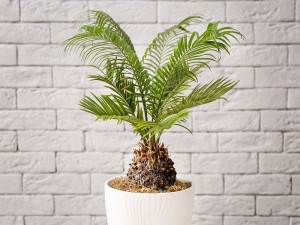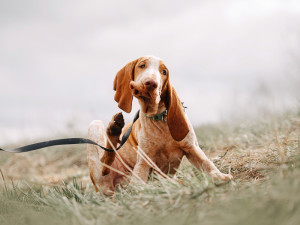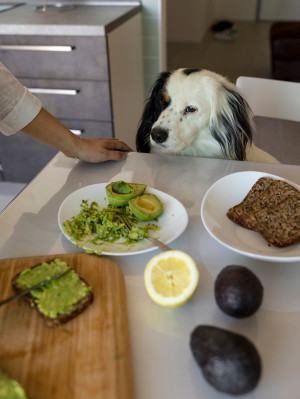Are Peace Lilies Toxic to Dogs?
Keep your pup far away from the toxic plant.
You love your dog like they are your child, but you also hold a tender place in your heart for your plant babies. They might not have the same kinds of needs as your four-legged kids, but you want them to thrive. So, what happens when your plants and your pups aren’t a great mix? For example, the peace lily is on all the “easy to care for” houseplant lists, so they might be a tempting addition to your collection of plant children, but take a second look before you bring a peace lily home to a house with a dog.
Are peace lilies toxic to my dog?
Peace lilies are a common houseplant known to be toxic to dogs. Dogs need to chew on and/or ingest parts of the plant to get sick. In most cases, they will make a full recovery even if they do get sick. Read on to learn about peace lily toxicity.
Why are peace lilies dangerous to dogs?
Peace lilies are dangerous to dogs because they contain a toxin that is very irritating to the mouth and digestive tract. They are part of the genus Spathiphyllumopens in new tab, which includes many different plants, all of which may be casually referred to as peace lilies, Mauna Loa peace lilies, spathe flowers, and/or white sails. These plants have shiny broad leaves and white flowers that resemble the shape of a sail. They are not technically true lilies and are native to tropical regions of South America and Asia. They thrive as houseplants even when they are moderately ignored or neglected, not that anyone would ever do such a thing.
How much do you spend on your pet per year?
You may have read about other kinds of lilies and their toxic effects opens in new tab on pets. True lilies can cause serious life-threatening problems for pets, especially in cats. Peace lilies are not true lilies, however, and their toxic effects are not usually as severe or life threatening. Their primary toxic property comes from calcium oxalate crystals found within the plant. When a dog chews on the plant, these crystals are released and can become lodged in the tissues of the mouth, throat, and/or digestive tract. These crystals are very irritating to the tissues and can cause pain, inflammation, and in severe cases, swelling of the throat, trouble swallowing, and/or difficulty breathing.
What should I do if my dog has eaten a peace lily?
If you observe your dog eating a piece of the plant or trying to eat it, do your best to take it away from them right away. You can try to bribe your pup with something tastier, which would likely be nearly any food on hand because peace lilies are not known for their flavor. Try offering a treat or yummy snack to your pup so they will drop the plant and you can remove as much of the plant matter from the area as possible.
If your dog will allow it, try to remove any pieces of plant stuck in their mouth, too, and even gently flush their mouth out with some cool water. If you think your dog swallowed a large amount of plant material, or you did not directly observe your dog eating the plant and just found the remains of a plant crime scene, contact your vet and the ASPCA’s poison control hotlineopens in new tab to discuss the best course of action. The plan will likely depend on how much you suspect your pup ate, as well as any symptoms your dog is already showing.
Diagnosing Plant Poisoning in Dogs
The easiest way to diagnose your dog with plant toxicity is to directly observe your dog eating the plant. Many signs of plant toxicities are non-specific, meaning they could have been caused by a number of different underlying problems. It may be difficult to determine if that was the exact cause of their illness if you did not see your dog eating the plant.
If you are concerned that your pet is sick from eating a plant, be sure to bring in part of the plant or a photo of the plant when you bring your dog to the vet so you can provide as much helpful information as possible. It is always a good idea to get your dog to the vet if they are acting sick, even if you are unsure of the cause. Your vet will do a thorough exam and diagnostic tests to help figure it out. Even if you and your vet are unable to determine the exact cause, your vet can treat the symptoms that are bothering your pup and get them feeling better fast.
Symptoms of Peace Lily Poisoning in Dogs
Peace lilies cause problems for dogs when they are chewed up, releasing tiny, sharp, calcium oxalate crystals, which then lodge in their tissues, causing pain and inflammation. Depending on where the bulk of these crystals get stuck, the symptoms can vary and may include:
Drooling: Also known as hypersalivation, you may notice your dog drooling profusely if their mouth is irritated from the crystals in the peace lilies. They may hold their mouth open, or you may see saliva collecting at the corners of the mouth.
Pain: These crystals are sharp and scratchy and cause a lot of pain and inflammation as they poke into the delicate tissues of the mouth and digestive tract. Your dog may express pain by whining, pawing at their mouth, refusing to eat or drink, acting lethargic, and/or by hiding or avoiding interactions with other pets and people in the home.
Vomiting: If these crystals make their way down into the stomach and intestines, they cause inflammation within the digestive tract. This can lead to nausea and vomiting.
Diarrhea: As the intestines become inflamed, they become less effective at absorbing nutrients and water and their movement may either speed up or slow down. This can cause diarrhea. Your pup may need to go more urgently, so be sure to offer more frequent walks and consider isolating them to a part of the house where their potential accidents will do less damage in the short-term.
Trouble swallowing: The irritation from these pointy crystals can cause swelling all along their path. This may include swelling of the lips, tongue, and throat. If the tongue and/or throat become very swollen, this can lead to difficulty swallowing. You may notice that your dog avoids eating and drinking altogether, or they may cough when they try to eat or drink. This is a medical emergency and should be evaluated by a vet right away.
Difficulty breathing: Swelling of the tissues within the mouth and throat could also cause difficulty breathing in extreme cases. This is very unusual with peace lily but it is helpful to know what to look out for. If your dog’s mouth and throat become very swollen, they may have very loud breathing, wheezing, coughing and/or labored breathing. This is considered a medical emergency, and you should get your dog to a vet right away.
Treatment
Most cases of peace lily toxicity are self-limiting, meaning that the signs will resolve on their own without any need for medical intervention. Your pup should be feeling much better within 24 hours. You can try offering a small amount of soothing liquid, such as licks of low-fat plain yogurt or low-sodium chicken broth, to help flush the crystals out of the mouth and/or throat. If your dog is acting very pained, not eating, or has signs of trouble swallowing or difficulty breathing, you should seek veterinary care right away. Treatment may include anti-nausea medications, pain medication, and more intensive care if they are having trouble swallowing and/or breathing.
How to Prevent Peace Lily Poisoning
The best way to prevent peace lily toxicity is to completely avoid opportunities for your pup to taste one.
One solution is to give away your peace lily to a pet-less friend and make sure to keep only safe, non-toxic houseplants in your home. If you are really attached to your peace lily (or maybe it is the only plant that has managed to survive your loving neglect), be sure to keep it far out of reach of your pets. Ideally, keep it in a room with a door that closes securely so your dog cannot get to it.
Are all parts of the peace lily poisonous to dogs?
Unfortunately, the entire plant contains these calcium oxalate crystals, which can cause pain and swelling to the tissues if the plant is chewed on or swallowed. For this reason, it is best to keep the plant in a room where your dog will not have access to it at all, or keep them out of your home completely. Sometimes plants drop leaves, so even keeping a peace lily up high on a shelf does not guarantee your dog won’t get hold of a leaf and take a bite.
How do I stop my dog from eating a peace lily?
The best approach is to avoid a situation where your dog could have any access to a peace lily. This means that you should keep peace lilies out of your home — or at least out of reach of your dog. If you do have one in your home, try to keep it in a room with a door that shuts securely and keep your dog out of that space. You can also consider crate training your dog to create a safe space for your pup to hang out when unsupervised.
This is a great tool to have for many reasons, aside from protecting your plants. It will generally protect your dog from eating and chewing on dangerous things around your home and may prevent poop and pee accidents for pups who are still potty training. It can also help give your dog a sense of security and structure if they know that is their special place to go where they won’t be bothered by other pets, small children, or overly affectionate house guests. Finally, you can work on training your dog to respond to a “leave it” so that if you encounter plants or other dangerous objects when outside of your home, you can quickly get your pup’s attention and redirect them to safer activities.
The bottom line: Are peace lilies poisonous to my dog?
Peace lilies are poisonous to dogs. While most cases will cause mild discomfort and pain, in severe cases, the swelling caused by calcium oxalate crystals in the plant could cause serious problems with swallowing and/or breathing. The best approach is to keep your pup and your peace lily far away from each other and to develop good habits for keeping your pup safe from these and other toxic houseplants. Dogs have a way of getting into unexpected mischief when we least expect it, so the more proactive you can be about keeping your pup in a safe space and removing possible dangers, the more you can avoid serious accidents for your pup.
Other Houseplants That Are Safe for Dogs:
There are lots of houseplants that are safe to cohabitate with your pup, so consider adding some of these instead of the more toxic varieties.
Spider Plants: These plants are easy to care for and have cute little baby plantlets that can be propagated into their own separate plants, providing free plants forever.
Tillandsia: Commonly called air plants, these stylish plants do not require a pot or any soil to grow. You can perch them on your most moody driftwood collection or atop your favorite thrift store ceramics for an easy design feature.
Staghorn Ferns: With beautiful leaves and fairly easy maintenance, you can mount a staghorn fern on your wall for a dramatic and pet-safe focal point.
Other Houseplants That Are Toxic for Dogs:
If you are in the market for a new houseplant be sure to double check whether or not it is toxic opens in new tab to your pets. There are some popular houseplants that can cause serious illness to pets and it is best to avoid them. This includes:
Cyclamen: The toxin in these plants is known as triterpenoid saponins which can cause vomiting, diarrhea, seizures and/or heart problems when ingested.
Sago Palm: These plants contain a toxin called Cycasin which can cause serious illness and even death when ingested.
Pothos: Similar to the peace lily, Pothos also contains calcium oxalate crystals that can cause pain and swelling when chewed.
FAQs (People Also Ask):
What happens if a dog eats a peace lily?
Peace lily ingestion can cause pain and swelling in the mouth, throat, and digestive tract. Seek veterinary care if your dog is in pain, not eating, or has trouble breathing and/or swallowing.
How much of peace lily does a dog have to eat for it to be toxic?
Any amount can cause signs of toxicity since it causes problems through contact. The more a dog eats, the more serious their signs are likely to be.
Can dogs eat peace lilies safely?
Dogs cannot eat peace lilies safely; this is a toxic plant that should be kept away from dogs.
Are peace lilies poisonous to dogs if they smell them?
Peace lilies are not poisonous if a dog smells them. A dog must chew on the plant in order for it to have toxic effects.














